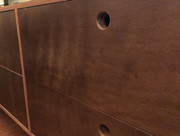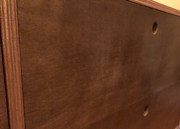Aurelius13100
New member
Hi everyone,
Here is my problem. I used plywood for a project, stained it (water based, so really easy to remove by sanding), and applied 4 coats of danish oil. Until the last coat, everything was fine, but after the last one, weird shiny wide lines appeared, visible from a certain angle only. I would like to start over the finish.
My question is : knowing that I used plywood, can I sand my piece to get the bare veneer back ? I'm a little afraid of sanding through it...
I sanded many times with 600 grit paper and steel wool 0000, but nothing seems to help. The veneer is not that thin (1mm for a 18mm plywood, the botton layer on the picture). The other pictures are the same area from various angles.
Thank you !



Here is my problem. I used plywood for a project, stained it (water based, so really easy to remove by sanding), and applied 4 coats of danish oil. Until the last coat, everything was fine, but after the last one, weird shiny wide lines appeared, visible from a certain angle only. I would like to start over the finish.
My question is : knowing that I used plywood, can I sand my piece to get the bare veneer back ? I'm a little afraid of sanding through it...
I sanded many times with 600 grit paper and steel wool 0000, but nothing seems to help. The veneer is not that thin (1mm for a 18mm plywood, the botton layer on the picture). The other pictures are the same area from various angles.
Thank you !








